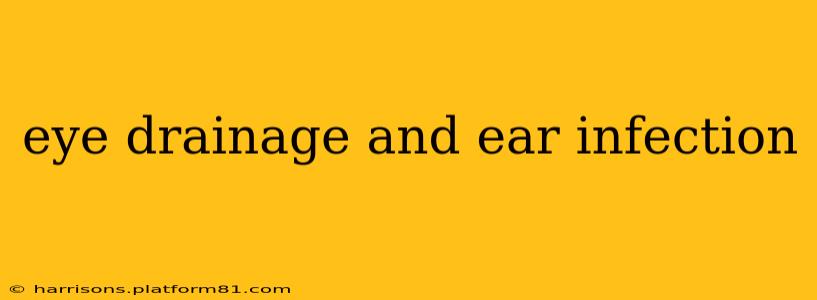Eye drainage and ear infections, while seemingly unrelated, can sometimes be linked, particularly in infants and young children. This connection often stems from the proximity of the structures involved and the potential spread of infection. Understanding the possible relationships between these conditions is crucial for effective diagnosis and treatment. This article explores the potential links, common causes, and when to seek professional medical attention.
What Causes Eye Drainage?
Eye drainage, also known as epiphora, can stem from various sources, ranging from simple irritants to serious infections. Common causes include:
- Conjunctivitis (Pinkeye): This highly contagious infection inflames the conjunctiva, the membrane lining the inside of the eyelids and covering the white part of the eye. It often leads to watery or pus-like drainage.
- Blocked Tear Ducts: Tears drain through small ducts into the nasal passages. Blockages in these ducts can cause excessive tearing and drainage. This is especially common in newborns.
- Allergies: Allergens like pollen or pet dander can irritate the eyes, resulting in increased tearing and watery discharge.
- Blepharitis: This inflammation of the eyelids can cause crusting and drainage.
- Styes or Chalazia: These are infections or blockages of the oil glands in the eyelids, leading to redness, swelling, and drainage.
Can an Ear Infection Cause Eye Drainage?
While an ear infection (otitis media) doesn't directly cause eye drainage, there's a crucial indirect link, especially in young children. The proximity of the ears, eyes, and nose means that an infection in one area can potentially spread to others. This is often facilitated by the Eustachian tubes, which connect the middle ear to the back of the throat. If an infection spreads from the ear to the throat, it can potentially reach the eyes via the tear ducts.
What are the symptoms of an ear infection that might be related to eye drainage?
Symptoms of an ear infection can include earache, fever, irritability, hearing difficulties, and sometimes, drainage from the ear itself. If these symptoms coincide with eye drainage, it warrants a medical evaluation to determine if there's a connection or a broader infection.
Does Eye Drainage Always Mean an Ear Infection?
No, eye drainage does not always indicate an ear infection. As mentioned earlier, many conditions can cause eye drainage independently of ear problems. It's essential to consider the complete clinical picture, including other symptoms and the patient's medical history.
What if my child has both eye drainage and an ear infection?
If your child exhibits both eye drainage and an ear infection, it’s crucial to consult a pediatrician or ophthalmologist promptly. This combination suggests a possible underlying infection that might require specific treatment. Delaying treatment could lead to complications.
How are eye drainage and ear infections treated?
Treatment for eye drainage depends on the underlying cause. Bacterial conjunctivitis might require antibiotic eye drops or ointment, while allergies may respond to antihistamines or eye drops. Blocked tear ducts sometimes resolve spontaneously, but in some cases, require probing or surgery.
Ear infections are often treated with antibiotics, although watchful waiting is sometimes an option for mild infections. Pain relievers can help manage discomfort.
When Should I See a Doctor for Eye Drainage?
Seek medical attention if:
- Drainage is severe, purulent (pus-like), or bloody.
- Your child is very young (infant or toddler).
- There's significant redness, swelling, or pain in the eye.
- Vision is affected.
- Symptoms don't improve after a few days of home care.
This information is for general knowledge and doesn't replace professional medical advice. Always consult a healthcare professional for diagnosis and treatment of eye drainage and ear infections.
